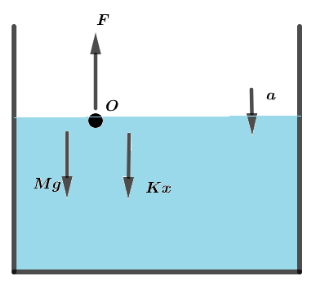
A cork is submerged in water by a spring attached to the bottom of a bowl. When the bowl is kept in an elevator moving with acceleration in downward direction, the length of spring.
A. Increases
B. Decreases
C. Remains unchanged
D. None of these
Answer
507k+ views
Hint: We will use the concept of upthrust force which will be acting on spring when the cork-spring system will start to move in downward direction in an elevator. An object when partially or completely submerged experiences a greater pressure on its bottom surface than on top which results in a net force acting on an object in upward direction.
Complete step by step answer:
Let us draw a rough diagram where we can see, cork is submerged and the weight of objects acting in downward direction whereas. According to Hooke’s law the force on spring is represented as $F = - kx$ where $k$ is spring constant and the buyout force is in upward direction due to the acceleration of the elevator in downward direction. Force due to gravity in downward direction $ = mg$

Here, $O$ represents the object and various forces acting on it when the elevator starts to move in a downward direction. The upthrust force on cork due to a net acceleration of $(g - a)$ will be $F = \rho V(g - a)$ Where $\rho $ is density of liquid. Since the net upthrust force gets decreased which will result in compression of the spring, as the force on spring will also get decreased but in the opposite direction. So, the length of spring will decrease.
Hence, the correct option is B.
Note: Hooke’s law states that the force needed to extend or compress a spring by some distance scales linearly with respect to that distance. Let $x$ be the distance up to which spring is either compressed or extended ten the force on spring will be $F = - kx$ where $k$ spring is constant and negative direction represents the restoring force due to the spring which results in displacement of the spring.
Complete step by step answer:
Let us draw a rough diagram where we can see, cork is submerged and the weight of objects acting in downward direction whereas. According to Hooke’s law the force on spring is represented as $F = - kx$ where $k$ is spring constant and the buyout force is in upward direction due to the acceleration of the elevator in downward direction. Force due to gravity in downward direction $ = mg$

Here, $O$ represents the object and various forces acting on it when the elevator starts to move in a downward direction. The upthrust force on cork due to a net acceleration of $(g - a)$ will be $F = \rho V(g - a)$ Where $\rho $ is density of liquid. Since the net upthrust force gets decreased which will result in compression of the spring, as the force on spring will also get decreased but in the opposite direction. So, the length of spring will decrease.
Hence, the correct option is B.
Note: Hooke’s law states that the force needed to extend or compress a spring by some distance scales linearly with respect to that distance. Let $x$ be the distance up to which spring is either compressed or extended ten the force on spring will be $F = - kx$ where $k$ spring is constant and negative direction represents the restoring force due to the spring which results in displacement of the spring.
Recently Updated Pages
Why are manures considered better than fertilizers class 11 biology CBSE

Find the coordinates of the midpoint of the line segment class 11 maths CBSE

Distinguish between static friction limiting friction class 11 physics CBSE

The Chairman of the constituent Assembly was A Jawaharlal class 11 social science CBSE

The first National Commission on Labour NCL submitted class 11 social science CBSE

Number of all subshell of n + l 7 is A 4 B 5 C 6 D class 11 chemistry CBSE

Trending doubts
What is meant by exothermic and endothermic reactions class 11 chemistry CBSE

10 examples of friction in our daily life

One Metric ton is equal to kg A 10000 B 1000 C 100 class 11 physics CBSE

1 Quintal is equal to a 110 kg b 10 kg c 100kg d 1000 class 11 physics CBSE

Difference Between Prokaryotic Cells and Eukaryotic Cells

What are Quantum numbers Explain the quantum number class 11 chemistry CBSE




